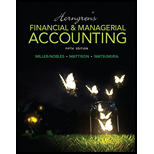
1.
Liabilities
Liabilities are the obligations of the business to pay the creditors and others, towards purchasing goods and services on account, and/or other financial benefits received. Liabilities can be short term (current liability) or long-term depending upon the time it is paid-off. While current liabilities are paid within one year, on the other hand, long-term liabilities are paid over one year period.
Rules of debit and credit:
“An increase in an asset account, an increase in an expense account, a decrease in liability account, and a decrease in a revenue account should be debited.
Similarly, an increase in liability account, an increase in a revenue account and a decrease in an asset account, a decrease in an expenses account should be credited”.
To Journalize: The transaction to record the collection of cash on June 1.
2.
To Journalize: The transaction required at December 31, with assumption that no revenue earned has been recorded.
Want to see the full answer?
Check out a sample textbook solution
Chapter 11 Solutions
Horngren's Financial & Managerial Accounting Plus Mylab Accounting With Pearson Etext -- Access Card Package (5th Edition) (miller-nobles Et Al., The Horngren Accounting Series)
 Intermediate Accounting: Reporting And AnalysisAccountingISBN:9781337788281Author:James M. Wahlen, Jefferson P. Jones, Donald PagachPublisher:Cengage Learning
Intermediate Accounting: Reporting And AnalysisAccountingISBN:9781337788281Author:James M. Wahlen, Jefferson P. Jones, Donald PagachPublisher:Cengage Learning
